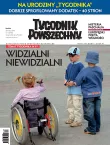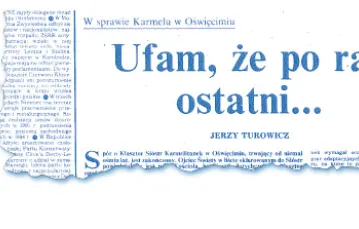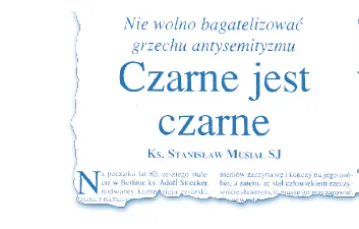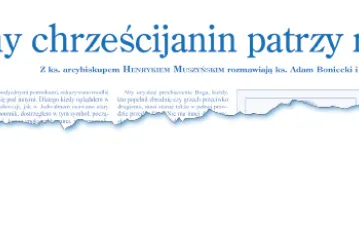Wykupienie dostępu pozwoli Ci czytać artykuły wysokiej jakości i wspierać niezależne dziennikarstwo w wymagających dla wydawców czasach. Rośnij z nami! Pełna oferta →
Stanisław Musiał’s text appeared in Tygodnik Powszechny No. 32/98. At that time, a campaign initiated by Kazimierz Świtoń was under way to erect further crosses at the gravel pit - a place, situated outside the perimeter of the Auschwitz concentration camp, where the Germans had shot over one hundred Polish political prisoners during the Second World War (a so-called Papal Cross has stood at the gravel pit since 1988, being one element of the altar at which John Paul II prayed during his visit to Auschwitz in 1979). “Mr Świtoń’s campaign did not emerge on a whim, but rather due to the constant and increasing harassment by Jews for the cross to be removed," said the Primate of Poland, Cardinal Józef Glemp, calling Father Musiał an “advocate of the Jewish position." Although a few days later the Primate softened his view and called on bishops to halt the spread of this “non-church campaign," the Jesuit Provincial managed to ban the Tygodnik Powszechny columnist from making further public statements on this and similar issues. At the end of May 1999, all the crosses, with the exception of the Papal Cross, were transferred to the Franciscan priory in the village of Harmęże near Oświęcim.
A few days ago, near the former Auschwitz concentration camp, a second three-metre cross was erected at the gravel pit. It was placed next to the existing seven-metre cross, which was put there ten years ago by “unknown" perpetrators under cover of night. The second cross was erected by known “perpetrators" in broad daylight, who announced their feat in the media. Some people predict that the gravel pit will soon become a forest of crosses. Thus, it is presumably set to become a “valley of crosses."
The shameful game of crosses at Auschwitz continues. Of course, what is involved here is neither God nor the honouring of the memory of those murdered at the Auschwitz camp. For nearly forty-five years after the Second World War, neither Catholics nor patriots took an interest in the place. It was overgrown with tall grass.
Who should stop this game? In this country, there is an institution which, in view of its calling, should put an end to this duel with crosses at Auschwitz. Yet, all the indications are that this institution has hidden its head in the sand and, worse still, wants public opinion in Poland and abroad to recognise its silence as a manifestation of the virtue of prudence and of civic discretion.
There was a time in Poland when the Church knew how to defend religion. It was able to react quickly, precisely, and decisively against the dangers, both external and internal, to which faith was exposed. This was especially so in the case of the profanation of religious symbols and attempts to exploit religion for political purposes.
Today, in the changed political and social context, the Church seems unable to defend religion. It seems deaf and blind to the dangers posed by the extreme right. Yet, direct attacks on faith are less harmful to religion than the instrumental use of religion for non-religious purposes or for purposes contrary to religion (I have in mind, for instance, hatred amongst national or religious groups). The first of these forms of attack on religion mobilises the faithful, while the second dilutes religiousness and secularises it.
It is high time for the Church in Poland to wake up and speak out against the abuse of religious symbols for non-religious purposes. It is not true that the Church is power-
less in this regard. It has at its disposal an instrument that is the envy of all secular authorities. This instrument is neither a police force, which the Church does not have, nor the courts, nor parliament, nor regional assemblies. This instrument is the word, a clear statement as to when a symbol commonly regarded as a religious symbol is actually a religious symbol, i.e., when it fulfils a religious function, and when it does not fulfil such a function because it has been “profaned," in other words, when it has been used for a non-religious purpose. Such a declaration either deprives a recognised religious symbol of its sacredness or confirms it.
Contrary to what some say, the Church does not need to own the land where the “disputed" religious symbols are located. In such cases, the removal of symbols which do not fulfil the conditions of “religiousness" is a matter for the secular authorities, and not for the Church.
A declaration by the Church in Poland on this matter would be extremely important for two reasons:
First, the Church must clearly reaffirm its inalienable right in this matter. Indeed, it seems that in recent years the Church has not only failed to affirm this right but appears to have relinquished it in favour of groups that call themselves patriotic or Catholic. It cannot be the case that anyone may put up Christian religious symbols in public places and demand that the faithful, or even the Church, should defend these symbols as sacred Christian objects. This is inadmissible because, on the one hand, the use of religious symbols as a political weapon is on the rise and, on the other, these symbols are increasingly being used in advertising.
Second, a declaration by the Church that it alone can decide whether a given religious symbol actually fulfils a religious function would be especially important if such a symbol - regarded as “not fulfilling a religious function or even being contrary to it" - needed to be removed or moved (for it is possible that the symbol in question could acquire a religious significance if moved to another place).
Moreover, such a declaration would be important for the people performing such actions, since they would avoid unnecessary conflicts of conscience, i.e., that they were doing something contrary to religion or God.
Incidentally, that the decision concerning the Auschwitz crosses has been left solely to the local bishop is surprising. The Holy Father constantly stresses that bishops are responsible not only for their own dioceses but also for the Church as a whole. In this specific case, however, one does not discern the collegiality of Polish bishops. Quite the opposite.
Not only is the Bishop of Bielsko-Żywiec not being helped in his efforts to solve the problem, but his plans have actually been sabotaged. For how else should one interpret the profuse and general appeals to “Defend the Cross!" recently made by certain members of the Polish clergy? Do they not realise that such appeals are double-edged? It is possible to “defend" the cross whilst actually profaning it. In truth, it is not those who demand that the crosses at the gravel pit be transferred or removed who are against the Cross of Christ, but those who put them there and who want them to remain.
Christ’s Cross is not a clenched fist. That is what the crosses at the Auschwitz gravel pit are - at the insistence of those who built them and their supporters. They are clenched fists against.







